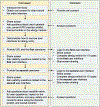Dynamic reaction picklist for improving allergy reaction documentation: A usability study
- PMID: 36529027
- PMCID: PMC10167939
- DOI: 10.1016/j.ijmedinf.2022.104939
Dynamic reaction picklist for improving allergy reaction documentation: A usability study
Abstract
Objective: To assess novel dynamic reaction picklists for improving allergy reaction documentation compared to a static reaction picklist.
Materials and methods: We developed three web-based user interfaces (UIs) mimicking the Mass General Brigham's EHR allergy module: the first and second UIs (i.e., UI-1D, UI-2D) implemented two dynamic reaction picklists with different ranking algorithms and the third UI (UI-3S) implemented a static reaction picklist like the one used in the current EHR. We recruited 18 clinicians to perform allergy entry for 10 test cases each via UI-1D and UI-3S, and another 18 clinicians via UI-2D and UI-3S. Primary measures were the number of free-text entries and time to complete the allergy entry. Clinicians were also interviewed using 30 questions before and after the data entry.
Results and discussions: Among 36 clinicians, less than half were satisfied with the current EHR reaction picklists, due to their incomprehensiveness, inefficiency, and lack of intuitiveness. The clinicians used significantly fewer free-text entries when using UI-1D or UI-2D compared to UI-3S (p < 0.05). The clinicians used on average 51 s (15 %) less time via UI-1D and 50 s (16 %) less time via UI-2D in completing the allergy entries versus UI-3S, and there was not a statistically significant difference in documentation time for either group between the dynamic and static UIs. Overall, 15-17 (83-94 %) clinicians rated UI-1D and 13-15 (72-83 %) clinicians rated UI-2D as efficient, easy to use, and useful, while less than half rated the same for UI-3S. Most clinicians reported that the dynamic reaction picklists always or often suggested appropriate reactions (n = 30, 83 %) and would decrease the free-text entries (n = 26, 72 %); nearly all preferred the dynamic picklist over the static picklist (n = 32, 89 %).
Conclusion: We found that dynamic reaction picklists significantly reduced the number of free-text entries and could reduce the time for allergy documentation by 15%. Clinicians preferred the dynamic reaction picklist over the static picklist.
Keywords: Documentation; Drug hypersensitivity; Drug-related side effects and adverse reactions; Electronic health record; Usability; User interface evaluation.
Copyright © 2022 Elsevier B.V. All rights reserved.
Conflict of interest statement
Declaration of Competing Interest The authors declare that they have no known competing financial interests or personal relationships that could have appeared to influence the work reported in this paper.
Figures




References
-
- Blumenthal KG, Park MA, Macy EM. Redesigning the allergy module of the electronic health record. Ann Allergy Asthma Immunol. 2016;117(2):126–31. PMID: 27315742. - PubMed
-
- Kuperman GJ, Teich JM, Gandhi TK, Bates DW. Patient safety and computerized medication ordering at Brigham and Women’s Hospital. Jt Comm J Qual Improv. 2001;27(10):509–21. PMID: 11593885. - PubMed
Publication types
MeSH terms
Grants and funding
LinkOut - more resources
Full Text Sources
Medical

